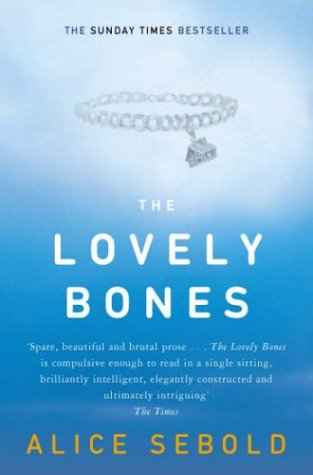All Nonfiction
- Bullying
- Books
- Academic
- Author Interviews
- Celebrity interviews
- College Articles
- College Essays
- Educator of the Year
- Heroes
- Interviews
- Memoir
- Personal Experience
- Sports
- Travel & Culture
All Opinions
- Bullying
- Current Events / Politics
- Discrimination
- Drugs / Alcohol / Smoking
- Entertainment / Celebrities
- Environment
- Love / Relationships
- Movies / Music / TV
- Pop Culture / Trends
- School / College
- Social Issues / Civics
- Spirituality / Religion
- Sports / Hobbies
All Hot Topics
- Bullying
- Community Service
- Environment
- Health
- Letters to the Editor
- Pride & Prejudice
- What Matters
- Back
Summer Guide
- Program Links
- Program Reviews
- Back
College Guide
- College Links
- College Reviews
- College Essays
- College Articles
- Back
The Lovely Bones by Alice Sebold
The Lovely Bones
Alice Sebold, author of Lucky (1999) and The Almost Moon (2007), won the American Booksellers Association Book of the Year Award for Adult Fiction in 2003 and the Bram Stoker Award for First Novel in 2002. All her works originate from Sebold’s own private experience of rape and murder. The Lovely Bones (2002) begins with a dramatic scene in which we, the readers, can live through Susie Salmon. We can experience the happiness and the horrors of her childhood right up to her last moment on Earth.
Susie is omniscient, knowing all thoughts and actions of all the characters, even her killer. Because of this, we can not imagine our own worlds and heavens. Much like Susie’s death, who her murderer was, or what Sebold envisions for the reader, the reality is “nothing is ever certain” (Sebold 21). This gives great advantages and disadvantages to the reader. On the positive side, Susie point of view seems to be like she is standing right next to the person she is observing. Since we are looking through Susie’s eyes and hearing through her ears, we can be directly involved in whatever a character is doing. From Abigail’s affair where “she needed Len to drive the dead daughter out” (152) to Lindsey’s first sexual moment, the reader does not need to use his or her own imagination to simulate the story in their head because Sebold describes it so vividly. On the negative side, because everything is laid out plain for the reader, it is hard to relate with the characters in the book if one does not agree with Sebold’s view. The reader is thrown all this information without explanation. Somehow Susie can see “what Mr. Harvey felt besides him” (292) and even explain his childhood. As much as Sebold tries to intertwine the lives of Susie’s family and friends, the information is tossed out for the reader to believe rather than applied in such ways that we can infer from it. We do not know how Susie manages to tell of others’ thoughts or their history, so the reader just has to accept and trust that everything she says is true. For example, Sebold describes heaven for Susie like an observatory of Earth, where the dead can watch the drama of the living. Susie virtually gets to watch her version of “Days of Our Lives” on NBC or the gazebo of her heaven. The heaven Sebold creates is very childish. It includes unlimited ice cream, a perfect climate, a babysitter, puppies, and another friend. Religious or not, this is not a strong setting for Susie to reside after her death, especially with the idea of heaven as being more perfect and fulfilling than mortals can imagine. Susie’s obsession with watching the living after she has died gives the reader a shallow perception of heaven.
The Lovely Bones is a great work of fiction with the blow of reality. For readers who believe any information the narrator gives, this book is highly recommended. For readers that prefer to gain their knowledge of events through their own imagination, this book may be frustrating. Proving how fiction can easily be reality, it gives a stronger establishment that nothing is ever certain.
Similar Articles
JOIN THE DISCUSSION
This article has 0 comments.

